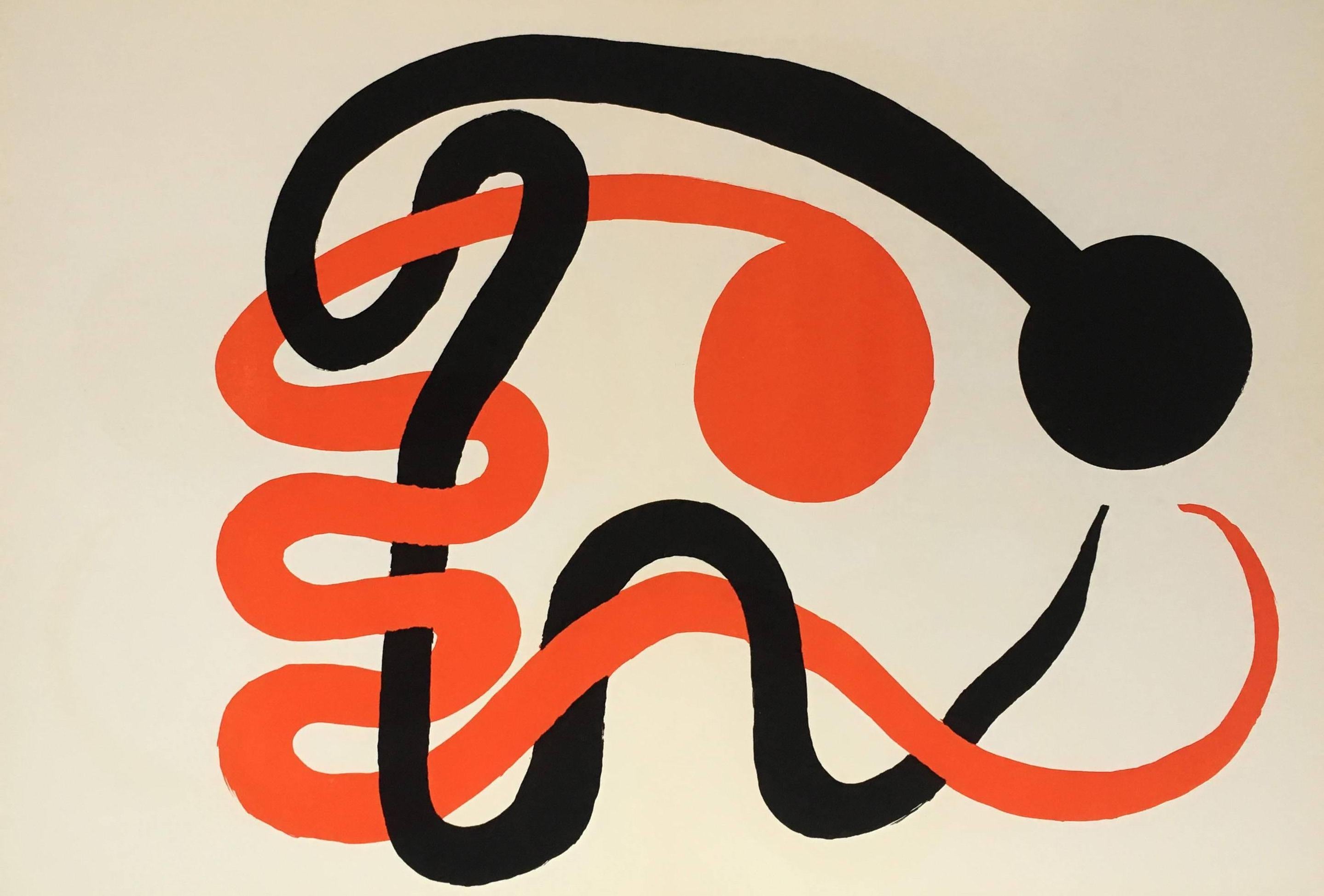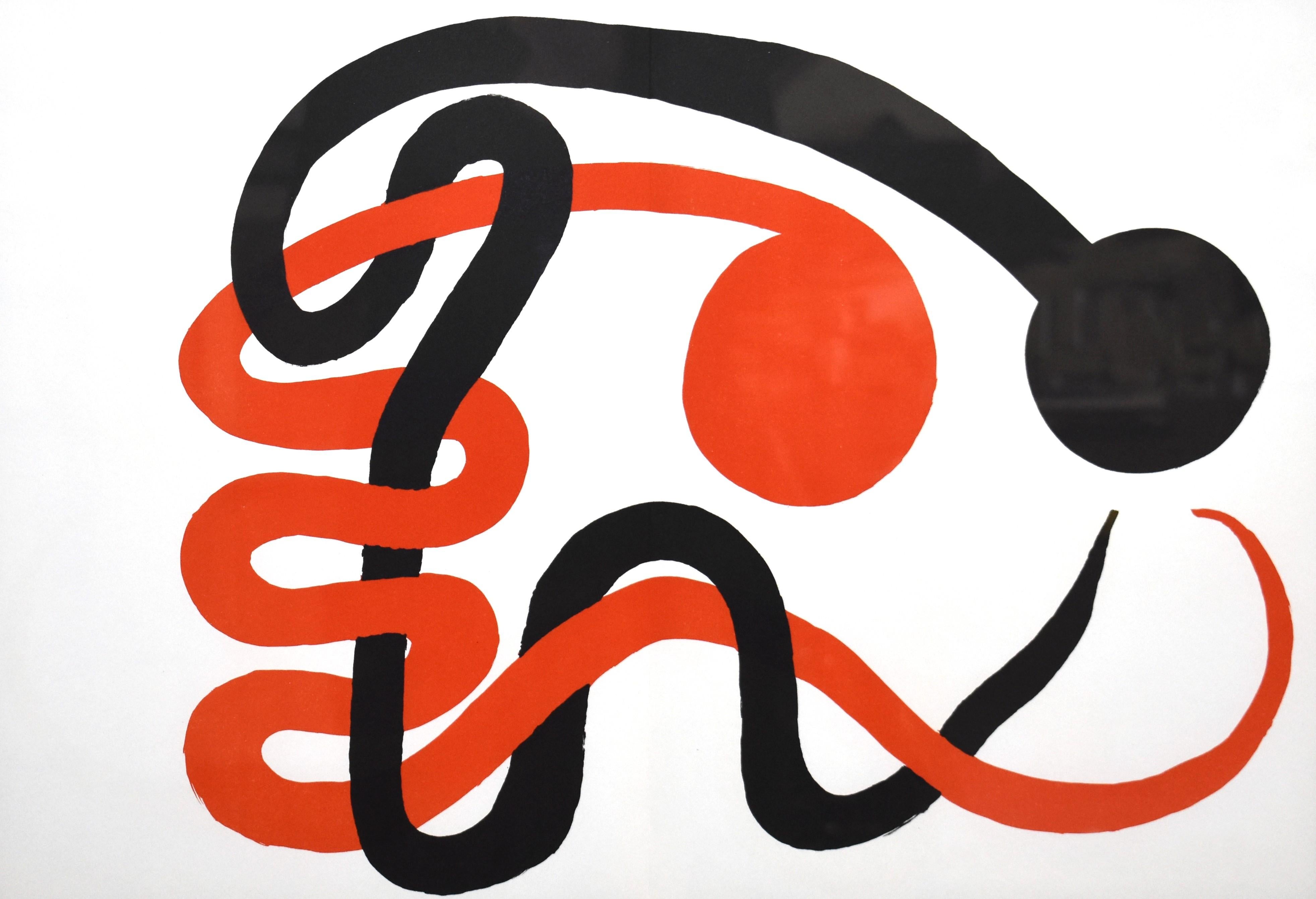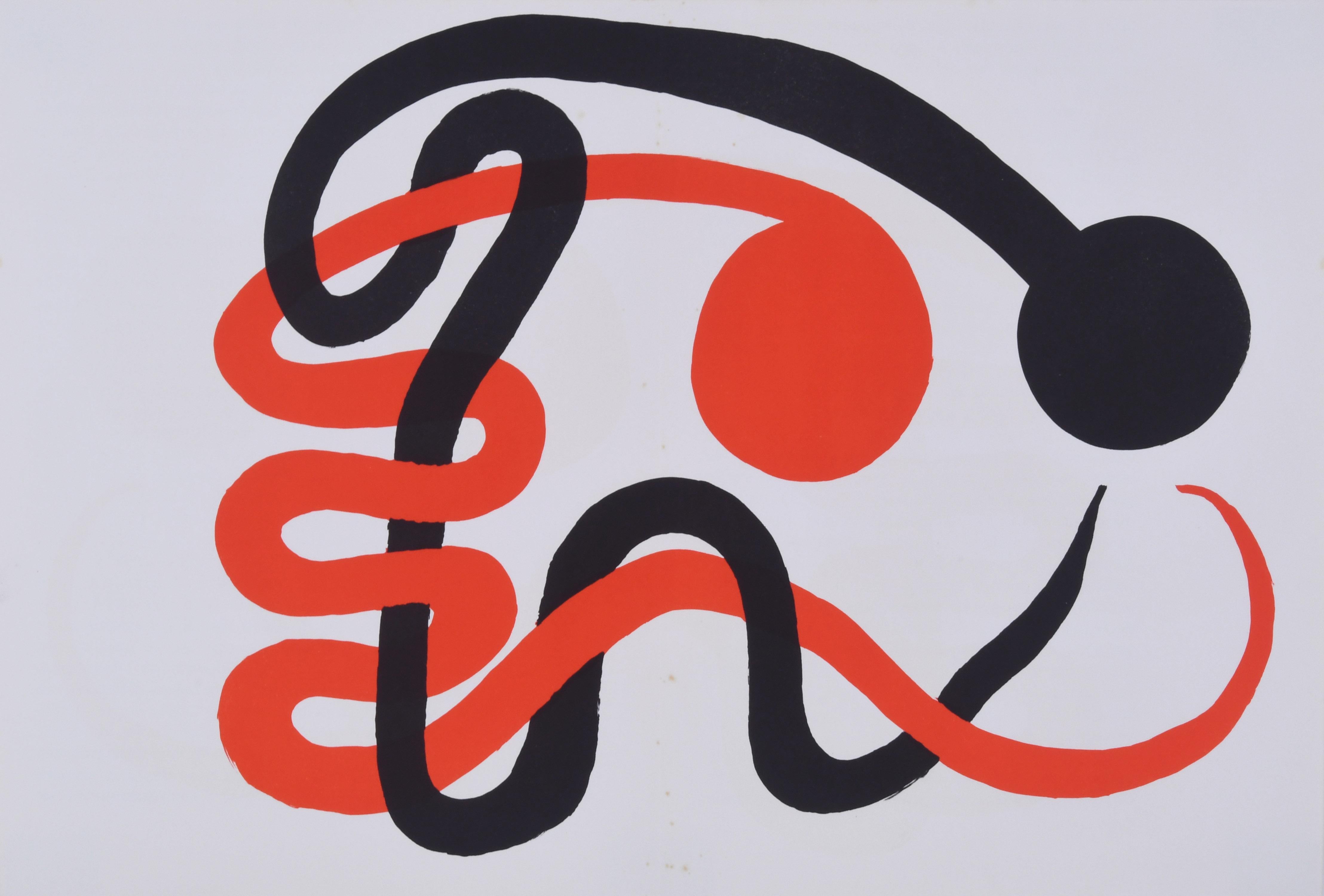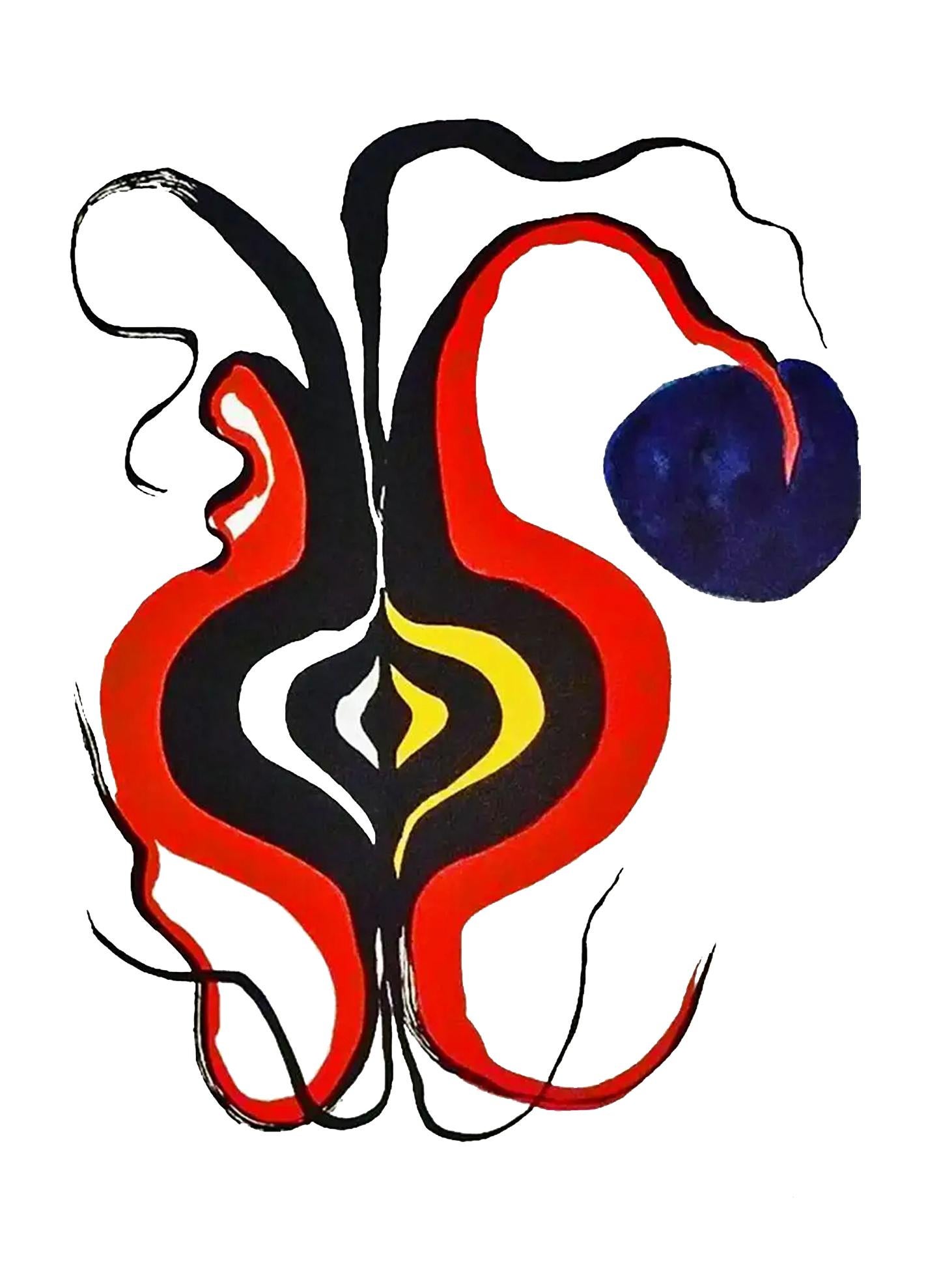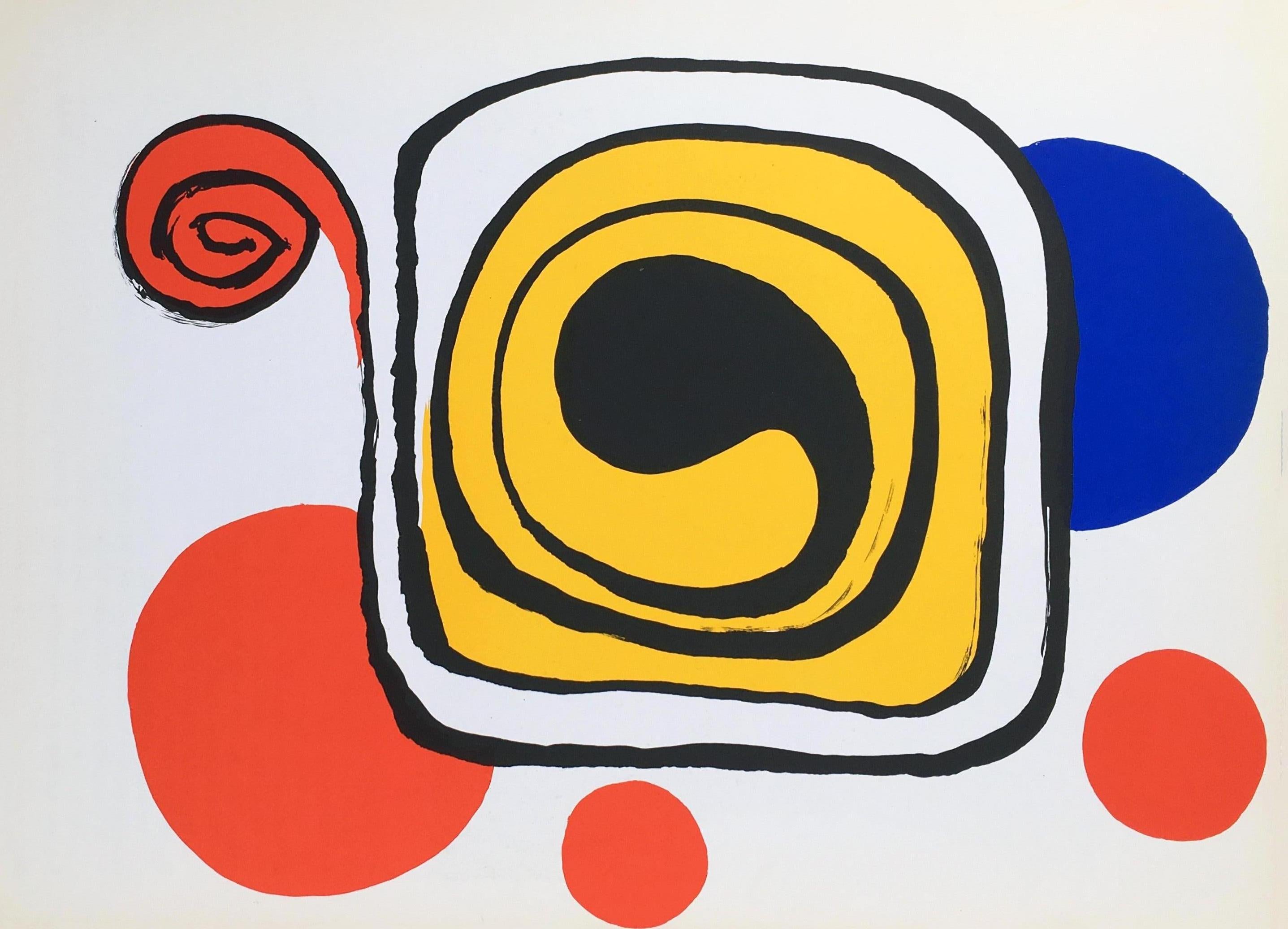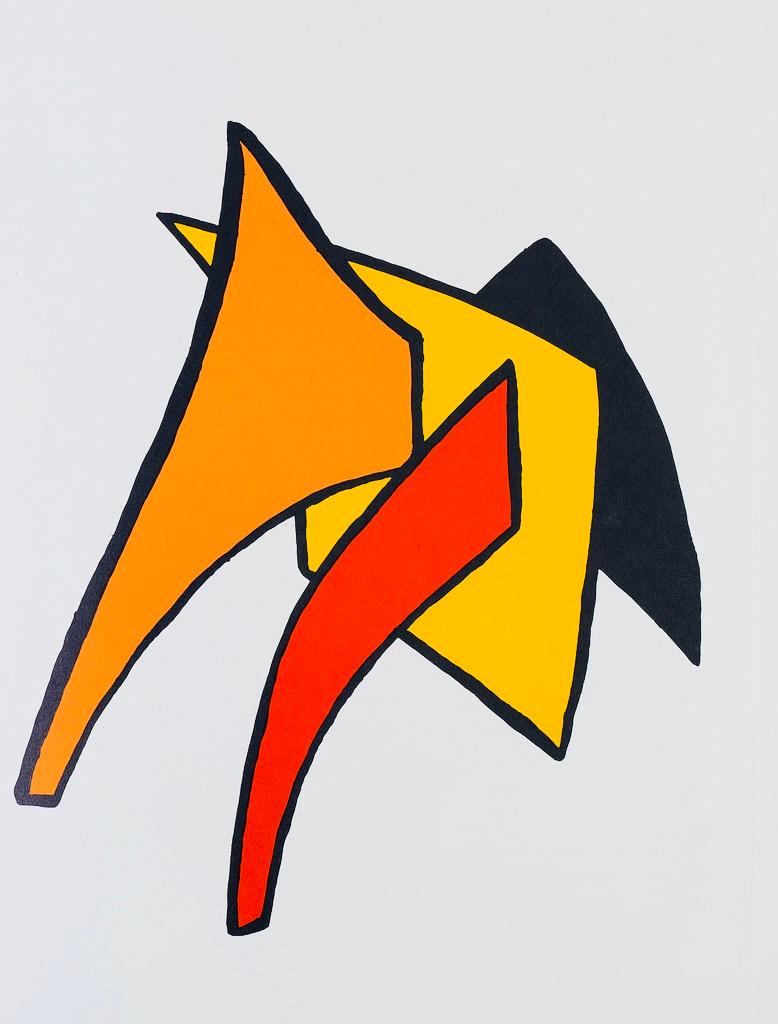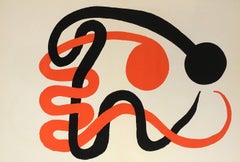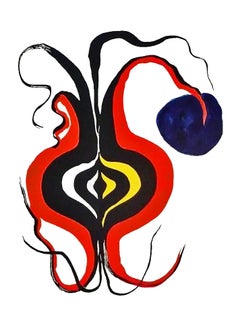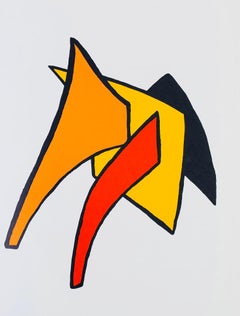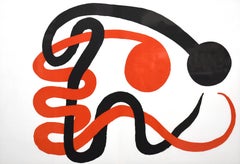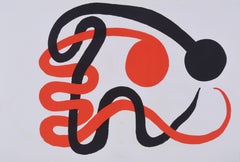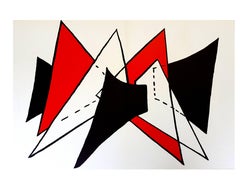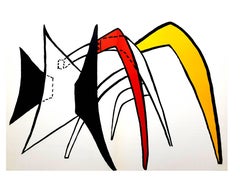Items Similar to Alexander Calder Lithograph Derrière le miroir (Calder serpents)
Want more images or videos?
Request additional images or videos from the seller
1 of 6
Alexander Calder Lithograph Derrière le miroir (Calder serpents)1973
1973
$500
£387.69
€439.69
CA$716.73
A$779.46
CHF 410.64
MX$9,466.67
NOK 5,162.53
SEK 4,839.45
DKK 3,301.08
About the Item
Alexander Calder Lithograph c. 1973 from Derrière le miroir:
Lithograph in colors; 15 x 22 inches.
Very good overall vintage condition; contains center fold-line as originally issued; well-preseved.
Unsigned from an edition of unknown.
From: Derrière le miroir Printed in France c. 1973.
Derrière le miroir:
In October 1945 the French art dealer Aimé Maeght opens his art gallery at 13 Rue de Téhéran in Paris. His beginning coincides with the end of Second World War and the return of a number of exiled artists back to France.
The publication was created in October 1946 (n°1) and published without interruption until 1982 (n°253). Its original articles and illustrations (mainly original color lithographs by the gallery artists) who were famous at the time.
The lithographic publication covered only the artists exhibited by Maeght gallery either through personal or group exhibitions. Among them were, Pierre Alechinsky, Francis Bacon, Alexander Calder, Marc Chagall, Eduardo Chillida, Alberto Giacometti, Vassily Kandinsky, Ellsworth Kelly, Fernand Léger, Henri Matisse, Joan Miró, Saul Steinberg and Antoni Tapies.
Alexander Calder was an American artist best known for his invention of the kinetic sculptures known as mobiles. Calder also produced a variety of two-dimensional artworks including lithographs, paintings, and tapestries as seen in his Butterfly (1970). “My whole theory about art is the disparity that exists between form, masses, and movement,” the artist once said. Born on August 22, 1898 in Lawnton, PA, Calder turned to art in the 1920s, studying drawing and painting under George Luks and Boardman Robinson at the Art Students League in New York. Calder moved to Paris to continue his studies in 1926, where he was introduced to the European avant-garde through performances of his Cirque Calder (1926–1931). “I was very fond of the spatial relations,” he said of his interest in the circus. “The whole thing of the—the vast space—I’ve always loved it.” With these performances, along with his wire sculptures, Calder attracted the attention of such notable figures as Marcel Duchamp, Jean Arp, and Fernand Léger. Notably, it was his friend Duchamp that coined the term mobile—a pun in French meaning both “motion” and “motive”—during a visit to Calder’s Paris studio in 1931. His earliest mobiles moved by motors, but Calder soon abandoned these mechanics and designed pieces that moved by air currents or human interaction. Over the course of seven decades, along with his mobiles, he also produced paintings, monumental outdoor sculptures, works on paper, domestic objects, and jewelry. The artist lived in both Roxbury, CT, and Saché, France, before his death on November 11, 1976 in New York, NY. Today, his works are held in the collections of The Museum of Modern Art in New York, the National Gallery of Art in Washington, D.C., the Whitney Museum of American Art, New York, the Art Institute of Chicago, and the Tate Gallery in London.
Related Categories
Calder prints. Calder Mid Century Modern. 1970s. Alexander Calder and Contemporary Art. Calder Deux Serpents. Joan Miro.
- Creation Year:1973
- Dimensions:Height: 15 in (38.1 cm)Width: 22 in (55.88 cm)
- Medium:
- Movement & Style:
- After:Alexander Calder (1898 - 1976, American)
- Period:
- Condition:Very good.
- Gallery Location:NEW YORK, NY
- Reference Number:1stDibs: LU354316027492
About the Seller
5.0
Vetted Professional Seller
Every seller passes strict standards for authenticity and reliability
Established in 2014
1stDibs seller since 2016
4,583 sales on 1stDibs
Typical response time: <1 hour
- ShippingRetrieving quote...Shipping from: New York, NY
- Return Policy
Authenticity Guarantee
In the unlikely event there’s an issue with an item’s authenticity, contact us within 1 year for a full refund. DetailsMoney-Back Guarantee
If your item is not as described, is damaged in transit, or does not arrive, contact us within 7 days for a full refund. Details24-Hour Cancellation
You have a 24-hour grace period in which to reconsider your purchase, with no questions asked.Vetted Professional Sellers
Our world-class sellers must adhere to strict standards for service and quality, maintaining the integrity of our listings.Price-Match Guarantee
If you find that a seller listed the same item for a lower price elsewhere, we’ll match it.Trusted Global Delivery
Our best-in-class carrier network provides specialized shipping options worldwide, including custom delivery.More From This Seller
View AllAlexander Calder Lithograph Derrière le miroir (Calder serpents)
By Alexander Calder
Located in NEW YORK, NY
Alexander Calder Lithograph c. 1973 from Derrière le miroir:
Lithograph in colors; 15 x 22 inches.
Very good overall vintage condition; contains center fold-line as originally issue...
Category
1970s Pop Art Prints and Multiples
Materials
Lithograph
Alexander Calder lithograph Derrière le miroir (Calder prints)
By Alexander Calder
Located in NEW YORK, NY
Alexander Calder Lithograph c. 1967 from Derrière le miroir:
Lithograph in colors; 15 x 11 inches.
Very good overall vintage condition; well-preserved.
Unsigned from an edition of u...
Category
Mid-20th Century Abstract Nude Prints
Materials
Lithograph
Alexander Calder lithograph Derrière le miroir (Calder prints)
By Alexander Calder
Located in NEW YORK, NY
Alexander Calder Lithograph c. 1971 from Derrière le miroir:
Lithograph in colors; 15 x 11 inches.
Very good overall vintage condition; well-preseved.
Unsigned from an edition of un...
Category
1970s Pop Art Prints and Multiples
Materials
Lithograph
Alexander Calder lithograph (derrière le miroir)
By Alexander Calder
Located in NEW YORK, NY
Alexander Calder Lithograph c. 1964 from Derrière le miroir:
Lithograph in colors; 15 x 11 inches.
Very good overall vintage condition; well-preserved.
Unsigned from an edition of unknown.
From: Derrière le miroir. Printed in France.
Derrière le miroir:
In October 1945 the French art dealer Aimé Maeght opens his art gallery at 13 Rue de Téhéran in Paris. His beginning coincides with the end of Second World War and the return of a number of exiled artists back to France. The publication was created in October 1946 (n°1) and published without interruption until 1982 (n°253).
Its original articles and illustrations (mainly original color lithographs by the gallery artists) who were famous at the time. The lithographic publication covered only the artists exhibited by Maeght gallery either through personal or group exhibitions.
Among them were, Pierre Alechinsky, Francis Bacon, Alexander Calder, Marc Chagall, Eduardo Chillida, Alberto Giacometti, Vassily Kandinsky, Ellsworth Kelly, Fernand Léger, Henri Matisse, Joan Miró, Saul Steinberg and Antoni Tapies.
_
Alexander Calder was an American artist best known for his invention of the kinetic sculptures known as mobiles. Calder also produced a variety of two-dimensional artworks including lithographs, paintings, and tapestries as seen in his Butterfly (1970). “My whole theory about art is the disparity that exists between form, masses, and movement,” the artist once said. Born on August 22, 1898 in Lawnton, PA, Calder turned to art in the 1920s, studying drawing and painting under George Luks and Boardman Robinson at the Art Students League in New York.
Calder moved to Paris to continue his studies in 1926, where he was introduced to the European avant-garde through performances of his Cirque Calder (1926–1931). “I was very fond of the spatial relations,” he said of his interest in the circus. “The whole thing of the—the vast space—I’ve always loved it.” With these performances, along with his wire sculptures, Calder attracted the attention of such notable figures as Marcel Duchamp, Jean Arp, and Fernand Léger. Notably, it was his friend Duchamp that coined the term mobile—a pun in French meaning both “motion” and “motive”—during a visit to Calder’s Paris studio in 1931.
His earliest mobiles moved by motors, but Calder soon abandoned these mechanics and designed pieces that moved by air currents or human interaction. Over the course of seven decades, along with his mobiles, he also produced paintings, monumental outdoor sculptures, works on paper, domestic objects, and jewelry.
The artist lived in both Roxbury, CT, and Saché, France, before his death on November 11, 1976 in New York, NY. Today, his works are held in the collections of The Museum of Modern Art in New York, the National Gallery of Art in Washington, D.C., the Whitney Museum of American Art, New York, the Art Institute of Chicago, and the Tate Gallery in London. Related Categories Calder prints. Mid Century Modern. 1970s. Miro. Chagall. Calder lithograph. Figurative art. Alexander Calder Derrière...
Category
1960s Contemporary Figurative Prints
Materials
Lithograph
$200 Sale Price
20% Off
Alexander Calder lithograph derrière le miroir (Calder prints)
By Alexander Calder
Located in NEW YORK, NY
Alexander Calder Lithograph c. 1973 from Derrière le miroir:
Lithograph in colors; 15 x 11 inches.
Very good overall vintage condition; well-preseved.
Unsigned from an edition of u...
Category
1970s Abstract Abstract Prints
Materials
Lithograph
$440 Sale Price
20% Off
1960's Alexander Calder lithographic cover Derrière le miroir
By Alexander Calder
Located in NEW YORK, NY
Alexander Calder Lithographic cover c. 1968 from Derrière le miroir:
Lithograph in colors; 11 x 15 inches.
Very good overall vintage condition.
Unsigned from an edition of unknown with crisp bright colors.
Published by: Galerie Maeght, Paris, c. 1968.
Unsigned from an edition of unknown.
Looks fantastic framed.
Derrière le miroir:
In October 1945 the French art dealer Aimé Maeght opens his art gallery at 13 Rue de Téhéran in Paris. His beginning coincides with the end of Second World War and the return of a number of exiled artists back to France.
The publication was created in October 1946 (n°1) and published without interruption until 1982 (n°253). Its original articles and illustrations (mainly original color lithographs by the gallery artists) who were famous at the time.
The lithographic publication covered only the artists exhibited by Maeght gallery either through personal or group exhibitions. Among them were, Pierre Alechinsky, Francis Bacon, Alexander Calder, Marc Chagall, Eduardo Chillida, Alberto Giacometti, Vassily Kandinsky, Ellsworth Kelly, Fernand Léger, Henri Matisse, Joan Miró, Saul Steinberg and Antoni Tapies.
Related Categories:
Mid century modern. Alexander Calder prints. Calder orange. Calder red...
Category
1960s Contemporary Figurative Prints
Materials
Lithograph
You May Also Like
Derriere le Miroir #201
By Alexander Calder
Located in Washington, DC
Artist: Alexander Calder
Title: Derriere le Miroir #201
Portfolio: Derriere le Miroir #201
Medium: Lithograph
Year: 1973
Edition: Unnumbered
Sheet Size: 22" x 15"
Image Size: 22" x 1...
Category
1970s Abstract Abstract Prints
Materials
Lithograph
Derriere Le Miroir-Page 6-7
By Alexander Calder
Located in Fairlawn, OH
Derriere Le Miroir-Page 6-7
Color lithograph, 1973
Unsigned (as issued)
From: Derriere Le Miroir, No. 201, January 1973
Publisher: Maeght Editeur, Paris
Printer: L’Imprimerie Arte, A...
Category
1970s Abstract Abstract Prints
Materials
Lithograph
Alexander Calder - Original Lithograph - from "Derrière le miroir"
By Alexander Calder
Located in Collonge Bellerive, Geneve, CH
Alexander Calder - Original Lithograph - from "Derriere le Miroir"Behind the Mirror
1976
Condition: Good Condition
Dimensions: 38 x 56 cm
Source: Derrière le miroir (DLM), n°141, 1...
Category
1970s Abstract Geometric Abstract Prints
Materials
Lithograph
Alexander Calder - Original Lithograph - from "Derrière le miroir"
By Alexander Calder
Located in Collonge Bellerive, Geneve, CH
Alexander Calder - Original Lithograph - from "Derriere le Miroir"Behind the Mirror
1976
Framed
Dimensions: 38 x 56 cm
Source: Derrière le miroir (DLM), n°141, 1976
Alexander Cald...
Category
1970s Abstract Geometric Abstract Prints
Materials
Lithograph
Plate 5, from Derriere Le Miroir #141 (Stabiles)
By Alexander Calder
Located in Washington, DC
Artist: Alexander Calder
Medium: Original lithograph
Title: Plate 5 Derriere le Miroir #141
Portfolio: Derriere Le Miroir #141 (Stabiles)
Year: 1963
Edition: Unnumbered
Signed: No
Fr...
Category
1960s Abstract Prints
Materials
Lithograph
Alexander Calder Mid Century Derrière le Miroir Lithograph
By Alexander Calder
Located in Soquel, CA
Vintage 1960s Alexander Calder Lithograph double page part of portfolio "Derriere le Miroir". Published by: Galerie Maeght, Paris, 1966. No. 156. Text on verso. Unsigned, from an unknown edition. Presented in black mat with red core. Mat size: 20"H x 24"W. Image size: 15"H x 22"W.
American artist Alexander Calder changed the course of modern art by developing an innovative method of sculpting, bending, and twisting wire to create three-dimensional “drawings in space.” Resonating with the Futurists and Constructivists, as well as the language of early nonobjective painting, Calder’s mobiles (a term coined by Marcel Duchamp in 1931 to describe his work) consist of abstract shapes made of industrial materials––often poetic and gracefully formed and at times boldly colored––that hang in an uncanny, perfect balance. His complex assemblage Cirque Calder (1926–31), which allowed for the artist’s manipulation of its various characters presented before an audience, predated Performance Art by some 40 years. Later in his career, Calder devoted himself to making outdoor monumental sculptures...
Category
1960s Modern Figurative Prints
Materials
Paper, Ink
$1,100 Sale Price
20% Off
More Ways To Browse
Alexander Calder Serpent
Essencies De La Terra
Eva Kolosvary Stupler
Faure Le
Flavin Poster
Francisco Moreno Capdevila
Frank Stella Sinjerli
Frank Stella The Whale Watch
Fred Berman
George Ennis
Gunther Gerzso
Hans Hartung On Sale
Helen Frankenthaler Lincoln Center
Helen Frankenthaler Poster
Highway Pop Art
Howard Hodgkin Poster
Howard Rose
Hubert Scheibl
